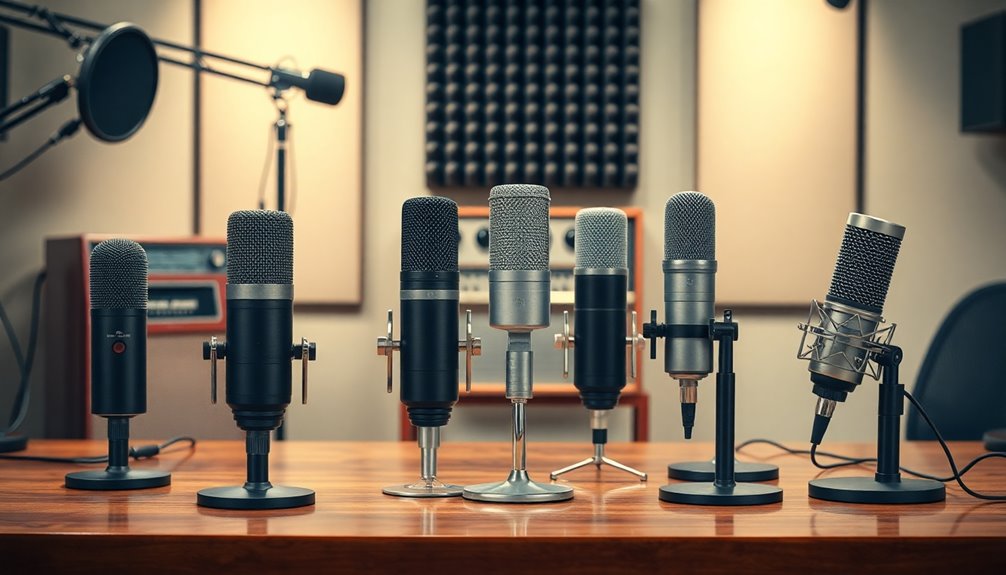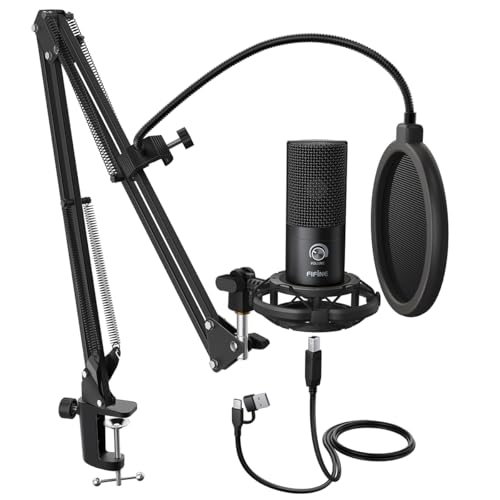Finding the right microphone can seriously boost your podcast's audio quality. I recommend starting with the Logitech Blue Yeti for its versatility or the Shure MV7+ if you're looking for something more professional. The FIFINE USB/XLR Dynamic Microphone provides excellent sound for any setup, while the Rode PodMic captures clear vocals beautifully. For budget-friendly options, check out the TONOR TC-777 or ZealSound USB Condenser Microphone. Each choice has unique features that cater to different needs. Stick around, and I'll help you explore the top contenders to take your podcasting game to the next level!
Key Takeaways
- Choose microphones with dual connectivity options, like USB and XLR, for flexibility in recording setups, such as the FIFINE USB/XLR Dynamic Microphone.
- Opt for models with cardioid pickup patterns, like the Rode PodMic and FIFINE Dynamic Microphone, to minimize background noise for clearer audio.
- Look for microphones with built-in features, such as mute buttons and headphone jacks, for easier real-time monitoring and control during recording sessions.
- Consider budget-friendly options, like the FIFINE Studio Condenser Kit, which offers quality sound and essential accessories without overspending.
- Prioritize sound quality and user experience by selecting microphones like the MAONO PD200XS that provide excellent audio clarity and convenient setups.
Logitech Blue Yeti USB Microphone for Gaming and Streaming
If you're looking for a versatile microphone that excels in gaming, streaming, and podcasting, the Logitech Blue Yeti USB Microphone is an outstanding choice. This mic features a tri-capsule array, delivering broadcast-quality sound that's clear and powerful. Whether I'm gaming on Discord or recording a podcast, its four pickup patterns—Cardioid, Omni, Bidirectional, and Stereo—offer flexibility for any situation. I love the plug-and-play setup; it works seamlessly with both PC and Mac. The onboard controls, including headphone volume and instant mute, make it super user-friendly. At 3.5 pounds, it's sturdy but not exactly portable, so I keep it on my desk. Overall, the Blue Yeti has become my go-to for all my audio needs.
Best For: The Logitech Blue Yeti USB Microphone is best for gamers, streamers, podcasters, and musicians looking for high-quality audio in a user-friendly package.
Pros:
- Excellent Sound Quality: Offers broadcast-quality sound with a tri-capsule array and multiple pickup patterns for versatile recording.
- Easy Setup: Plug-and-play functionality ensures seamless compatibility with both PC and Mac.
- User-Friendly Controls: Onboard controls for headphone volume, pattern selection, and instant mute enhance usability.
Cons:
- Ambient Noise Sensitivity: Highly sensitive to background noise, making it less suitable for uncontrolled environments.
- Size and Weight: Relatively large and heavy, which limits portability for on-the-go use.
- USB Connection Only: Lacks XLR output, restricting use in more advanced audio setups.
FIFINE USB/XLR Dynamic Microphone for Podcast Recording
The FIFINE USB/XLR Dynamic Microphone is a fantastic choice for podcasters seeking high-quality audio without breaking the bank. Weighing just 1.74 pounds and measuring 3.35 x 4.96 x 9.65 inches, it's compact yet durable, made from ABS plastic and metal. Its frequency response of 50Hz-16KHz provides natural audio clarity, while the cardioid pattern effectively minimizes background noise. I love the dual connectivity options—USB for easy plug-and-play or XLR for professional setups. The real-time monitoring feature through the headphone jack is a game-changer for checking levels. Plus, the customizable RGB lighting adds a nice touch. With a solid rating of 4.5 stars from over 4,200 users, it's a reliable option for any aspiring podcaster.
Best For: Aspiring podcasters and gamers seeking a budget-friendly microphone with high-quality audio performance.
Pros:
- Natural audio clarity with a frequency response of 50Hz-16KHz, ensuring balanced sound and minimized background noise.
- Dual connectivity options (USB for easy setup and XLR for professional use) offer flexibility for different recording environments.
- Real-time monitoring feature through a headphone jack allows users to check audio levels during recording.
Cons:
- Some users reported sensitivity to desk noise, which can affect recording quality.
- Requires additional software for optimal sound quality in certain setups, which may complicate the process for beginners.
- The plastic build may feel less premium compared to other higher-end microphones.
Shure MV7+ Podcast Dynamic Microphone
For podcasters seeking top-tier audio quality without the complexity of professional studio gear, the Shure MV7+ Podcast Dynamic Microphone stands out. This microphone features both USB-C and XLR outputs, making it incredibly versatile. The multi-color LED touch panel is not only stylish but also functional, offering a quick mute option and a real-time denoiser to keep your recordings crisp. I appreciate the improved Auto Level Mode, which adjusts gain based on my distance from the mic. With its sturdy metal construction and premium feel, the MV7+ feels reliable in hand. Plus, the ShurePlus MOTIV app lets me customize settings, ensuring my audio remains clear and professional. At $249, it's a worthy investment for any serious podcaster.
Best For: The Shure MV7+ Podcast Dynamic Microphone is best for podcasters and streamers who want high-quality audio without the complexity of professional studio equipment.
Pros:
- Excellent vocal clarity and effective background noise reduction.
- Versatile connectivity with both USB-C and XLR outputs.
- User-friendly customization through the ShurePlus MOTIV app.
Cons:
- Touch interface can be less responsive than physical controls.
- Some users may find the LED lighting distracting.
- Initial setup may require checking the tightness of mounting screws.
ZealSound USB Condenser Microphone for PC and Gaming
Looking for a microphone that combines ease of use with professional sound quality? The ZealSound USB Condenser Microphone is a fantastic choice. With its plug-and-play setup, you can start recording right out of the box—no complicated installations needed. I love its sleek design and 360-degree rotation, allowing for ideal positioning. The cardioid polar pattern effectively reduces background noise, ensuring my voice is crystal clear. Plus, the mic gain control and live monitoring via the headphone jack let me adjust settings on the fly. It's compatible with various devices, from PCs to iPhones, making it versatile for gaming, podcasting, or virtual meetings. With excellent audio performance and a solid build, this mic is a real winner!
Best For: The ZealSound USB Condenser Microphone is best for gamers, podcasters, and professionals seeking high-quality audio for streaming, recording, or virtual meetings.
Pros:
- Plug-and-play setup allows for immediate use without complicated installations.
- The cardioid polar pattern effectively minimizes background noise for clearer sound capture.
- Versatile compatibility with various devices, including PCs, laptops, and mobile phones.
Cons:
- Some users may find the mic gain control a bit sensitive, requiring careful adjustment.
- The design may not suit everyone's aesthetic preferences, as it's primarily sleek and minimalistic.
- No built-in battery, meaning it requires a USB connection to function, limiting portability.
Rode PodMic Cardioid Dynamic Broadcast Microphone, Black
If you're in search of a microphone that delivers broadcast-quality sound for your podcasting needs, the Rode PodMic is an exceptional choice. This dynamic microphone captures voices with remarkable clarity and warmth, thanks to its tight cardioid polar pattern that effectively minimizes background noise. Weighing in at 937 grams, it feels sturdy and professional, while the internal pop filter and shock mounting enhance your audio quality by reducing plosives and vibrations. Although it requires a bit more gain due to its low output, the sound quality makes it worth it. Plus, it's optimized for the RODECaster Pro but works well with any high-quality interface. With a stellar rating of 4.8 out of 5, it's a favorite among podcasters.
Best For: Podcasters and streamers seeking a durable, high-quality microphone that captures rich, clear sound.
Pros:
- Excellent sound quality with a cardioid pattern that minimizes background noise.
- Sturdy metal construction ensures durability and a professional appearance.
- Highly rated by users for its value for money and performance, with a rating of 4.8 out of 5.
Cons:
- Requires more gain due to low output, which can introduce noise if the preamp isn't clean.
- Lacks a built-in headphone jack for monitoring audio directly.
- Limited included accessories may necessitate additional purchases for optimal use.
FIFINE Dynamic Microphone for Podcast Recording
The FIFINE Dynamic Microphone, Amplitank K688, stands out as a top choice for anyone diving into the world of podcasting, thanks to its dual XLR and USB connectivity options. Weighing in at just over a pound, this robust metal microphone delivers impressive audio quality with a frequency range of 50Hz to 16KHz. Its cardioid pattern effectively reduces background noise, making your voice the star of the show. I love the real-time monitoring feature through the 3.5mm jack, and the gain knob allows for quick adjustments while recording. With its plug-and-play USB capability and solid build, it's a fantastic option for both beginners and seasoned podcasters. Plus, it's well-rated by users for sound clarity and ease of use.
Best For: The FIFINE Dynamic Microphone is best for podcasters, streamers, and voice-over artists seeking high-quality audio with user-friendly features.
Pros:
- Versatile connectivity with both XLR and USB options for various recording setups.
- Excellent sound quality with a cardioid pattern that minimizes background noise.
- User-friendly design with plug-and-play functionality and real-time monitoring.
Cons:
- Limited compatibility issues reported with specific USB ports.
- Mic stand and XLR cable not included, requiring additional purchases.
- Gain adjustments and monitoring features are only available in USB mode.
FIFINE Studio Condenser USB Microphone Kit (T669)
For podcasters seeking an affordable yet high-quality audio solution, the FIFINE Studio Condenser USB Microphone Kit (T669) stands out with its exceptional sound clarity and user-friendly design. Weighing just 700 grams, it's easy to set up and compatible with laptops, PCs, and even PS4/PS5. The cardioid condenser capsule effectively captures crisp audio while minimizing background noise, making it perfect for voice recordings. Plus, the package includes a sturdy mic boom arm, shock mount, and double pop filter, ensuring you've got everything you need. The plug-and-play functionality means you can start recording right away. With a customer rating of 4.6 out of 5 stars, it's clear that many users appreciate the value this microphone offers.
Best For: Podcasters and content creators looking for an affordable, high-quality microphone that offers excellent sound clarity and easy setup.
Pros:
- Affordable price point.
- High-quality sound for voice recordings.
- Sturdy accessories included.
Cons:
- Adjustable stand may become loose over time.
- Some users noted background noise pickup.
- Lacks headphone input.
MAONO XLR/USB Dynamic Microphone Kit (PD200XS)
Looking for a versatile microphone that adapts to both studio and on-the-go recordings? The MAONO XLR/USB Dynamic Microphone Kit (PD200XS) might just be what you need. With dual USB and XLR interfaces, it's perfect for any setup. Weighing just 350 grams, it's portable yet sturdy, ideal for podcasting, gaming, or voiceovers. Its cardioid polar pattern reduces background noise, ensuring your voice shines through clearly. I love the built-in mute button and LED indicator for quick adjustments. Plus, the RGB lighting adds a fun touch! The included shock mount and adjustable boom arm make positioning a breeze. If you're looking for excellent sound quality without breaking the bank, this microphone's a fantastic option.
Best For: Content creators, podcasters, and gamers seeking a budget-friendly microphone with high-quality sound and versatile connectivity options.
Pros:
- Excellent sound quality with a cardioid polar pattern that reduces background noise.
- Dual USB and XLR interfaces for flexible connectivity in various recording setups.
- User-friendly design with a plug-and-play setup, built-in mute button, and adjustable boom arm for easy positioning.
Cons:
- Some users have reported disconnections with the accessories included in the kit.
- Concerns about the durability of certain accessories.
- Limited software customization options available only in USB mode through MAONO Link.
FIFINE Gaming PC USB Microphone with Boom Arm and Pop Filter
Designed with gamers and streamers in mind, the FIFINE Gaming PC USB Microphone stands out for its impressive sound quality and user-friendly features. I've found the plug-and-play setup incredibly convenient, compatible with PS4, PS5, Windows, and Mac OS. The upgraded cardioid capsule delivers warm, clear audio, perfect for immersive gameplay and streaming. Plus, the boom arm allows for easy adjustment, while the touch mute button guarantees I can quickly silence myself without missing a beat. The RGB lighting adds a nice visual element to my setup, and the included pop filter keeps my audio crisp by minimizing plosive sounds. With a 4.6-star rating from users, this mic is an excellent value for anyone serious about their audio quality.
Best For: Gamers, streamers, and content creators seeking high-quality audio with user-friendly features at an affordable price.
Pros:
- Easy plug-and-play setup compatible with multiple platforms including PS4, PS5, Windows, and Mac OS.
- Exceptional sound quality thanks to the upgraded cardioid capsule and effective background noise reduction.
- Adjustable boom arm and touch mute button for convenient positioning and quick silencing during streams.
Cons:
- RGB lighting may not appeal to users who prefer a more minimalist aesthetic.
- Limited frequency range (60Hz-18KHz) compared to some higher-end microphones.
- Weight (948 grams) could be considered bulky for portable setups.
FIFINE Gaming USB Microphone for PC and PS5
The FIFINE Gaming USB Microphone for PC and PS5 stands out with its exceptional audio clarity, making it a fantastic choice for gamers and podcasters alike. I love how its cardioid design minimizes background noise, ensuring my voice comes through crystal clear. The quick mute feature is a lifesaver during intense gaming sessions, and the RGB indicator adds a fun touch to my setup. With a sturdy tripod stand and shock mount, I don't have to worry about vibrations affecting my audio quality. Plus, it's plug-and-play, so setup is a breeze on all compatible platforms. For anyone looking for professional-grade sound without breaking the bank, this microphone is an excellent option. It's highly recommended for anyone serious about their audio experience.
Best For: Gamers, streamers, and content creators seeking high-quality audio performance at an affordable price.
Pros:
- Excellent sound quality with clear audio capture.
- Easy setup with plug-and-play functionality across multiple platforms.
- Sturdy build and sleek design enhance usability and aesthetics.
Cons:
- Requires close proximity for optimal sound capture.
- Background noise can be an issue if not properly isolated.
FIFINE XLR/USB Gaming Microphone Set for Streaming and Podcasting
If you're a budding podcaster or gamer seeking a reliable microphone that doesn't break the bank, the FIFINE XLR/USB Gaming Microphone Set is a fantastic choice. This dynamic microphone offers versatile connectivity with both USB and XLR options, making it perfect for casual and professional use. I love the cardioid polar pattern, which effectively minimizes background noise, ensuring my voice comes through clear and crisp. Plus, the customizable RGB lighting adds a fun touch to my setup. With a mute button, gain knob, and headphones jack, I have full control over my audio. Weighing just 2.6 pounds and featuring a sturdy design, it's durable and easy to position. Overall, it's an excellent investment for anyone serious about audio quality!
Best For: The FIFINE XLR/USB Gaming Microphone Set is best for beginners and content creators looking for an affordable yet high-quality microphone for streaming and podcasting.
Pros:
- Clear, crisp audio quality enhances voice clarity for streaming and recording.
- Affordable price point offers great value for the features provided.
- Durable construction with included accessories like a boom arm and C-clamp.
Cons:
- Requires an audio interface for XLR use, which may add to setup complexity.
- RGB lighting may not appeal to all users and could be distracting for some.
- Background noise may still be captured in noisy environments.
Shure SM7dB Dynamic Vocal Microphone for Streaming and Recording
For anyone serious about podcasting, the Shure SM7dB Dynamic Vocal Microphone stands out with its built-in preamp, providing up to +28 dB of low-noise gain. The warm tone mirrors the beloved SM7B, making it a fantastic choice for capturing vocals. With adjustable gain levels and a cardioid polar pattern, it isolates your voice beautifully while minimizing background noise. I love how its rugged construction guarantees durability, whether I'm using it in the studio or on stage. Plus, the sound quality is exceptional, delivering professional-grade audio that enhances every recording. Users rave about its ease of setup and immediate impact on sound quality, proving it's worth the investment for anyone looking to elevate their audio game.
Best For: The Shure SM7dB Dynamic Vocal Microphone is best for podcasters, streamers, and musicians seeking professional audio quality in both studio and live settings.
Pros:
- Exceptional sound quality with warm tone and clarity, ideal for vocals.
- Built-in preamp provides adjustable gain levels for versatile use.
- Durable construction designed for both studio and stage environments.
Cons:
- Higher price point may be a barrier for entry-level users.
- Requires additional equipment such as a good audio interface for optimal performance.
- Weight may be a consideration for those using lightweight boom arms.
Amcrest USB Microphone for Voice Recordings (AM430)
Looking for a reliable microphone that delivers exceptional sound quality for solo podcasting? The Amcrest USB Microphone (AM430) is an excellent choice. Its cardioid polar pattern effectively reduces background noise, ensuring clarity in your recordings. The sturdy metal housing and adjustable stand give it a solid feel, making it easy to find the perfect angle. With a plug-and-play setup, you can start recording in no time, thanks to the included 6.5 ft USB cable. While it shines in solo use, be aware that it may pick up breathing sounds and ambient noise. Overall, with a 4.5-star rating and positive feedback on its audio quality, the AM430 is a fantastic addition to your podcasting toolkit.
Best For: Solo podcasters and streamers looking for high-quality audio recordings in a compact and user-friendly design.
Pros:
- High-quality audio with clarity, making it ideal for voice recordings.
- Cardioid polar pattern effectively reduces background noise and echo.
- Sturdy metal construction and adjustable stand provide durability and flexibility in positioning.
Cons:
- May pick up breathing sounds and ambient noise, which could be distracting.
- Lack of noise-canceling features may limit performance in noisy environments.
- No gain adjustment or on/off switch makes it less versatile for different recording situations.
HyperX SoloCast USB Condenser Gaming Microphone
The HyperX SoloCast USB Condenser Gaming Microphone is perfect for podcasters who want high-quality audio without breaking the bank. With its plug-and-play USB-C connection, setting it up is a breeze—just connect it to your PC or Mac, and you're ready to go! I love its cardioid polar pattern, which effectively captures vocal sounds while minimizing background noise. The tap-to-mute feature is a game-changer, letting me quickly silence myself during recordings. Plus, the compact design and adjustable stand make it easy to fit anywhere. At a weight of just 261 grams, it's lightweight yet sturdy. With a 4.6-star rating from thousands of users, the SoloCast is a solid choice for anyone looking to elevate their podcasting game.
Best For: The HyperX SoloCast USB Condenser Gaming Microphone is best for podcasters, streamers, and gamers looking for high-quality audio at an affordable price.
Pros:
- Plug-and-play USB-C connection makes setup quick and hassle-free.
- Cardioid polar pattern effectively reduces background noise for clearer audio.
- Lightweight and compact design allows for easy placement on any desk setup.
Cons:
- Unmutes when the computer goes to sleep, requiring a workaround for users.
- Background noise pickup may occur without additional soundproofing measures.
- May require a pop filter for optimal vocal clarity, especially for certain sounds.
TONOR TC-777 Podcast Microphone for PC and Laptop
If you're diving into podcasting or streaming and want a microphone that delivers quality without breaking the bank, the TONOR TC-777 is a fantastic choice. This USB condenser mic features a cardioid pickup pattern, capturing your voice clearly while minimizing background noise. I love its plug-and-play functionality—just connect it to your PC or laptop, and you're ready to go. Plus, it's compatible with gaming consoles like PS4 and PS5. The adjustable design, complete with a tripod stand and pop filter, allows for easy customization. Weighing only 345 grams, it's lightweight and portable. With an impressive average rating of 4.3 stars from over 34,000 users, it's clear that this microphone is a reliable option for anyone looking to enhance their audio experience.
Best For: Those looking to enhance their podcasting, streaming, or vocal recording experience with an affordable and user-friendly microphone.
Pros:
- Plug-and-Play: Easy setup with no additional drivers required, making it accessible for beginners.
- Clear Audio Quality: Cardioid pickup pattern effectively isolates voice while reducing background noise.
- Lightweight and Portable: At only 345 grams, it's easy to transport and set up anywhere.
Cons:
- Sensitivity Issues: Some users report that the microphone may be overly sensitive in certain environments.
- Pop Filter Design: The included pop filter may require adjustments for optimal performance, based on user feedback.
- Limited Compatibility: Not compatible with Xbox, which may limit use for some gamers.
Factors to Consider When Choosing Microphones for Podcasts

When I'm picking out a microphone for my podcast, there are a few key factors I always consider. I think about the type of microphone I need, the connectivity options available, and the sound quality I want to achieve. Plus, budget and portability play a big role in my decision-making process.
Microphone Type Selection
Choosing the right microphone can make or break your podcasting experience. When I'm selecting a microphone, I first consider the type. Dynamic microphones are my go-to for their ability to minimize background noise, making them perfect for home studios. On the other hand, condenser microphones capture more detail and provide exceptional vocal clarity, which might be great for certain situations.
Next, I pay attention to the polar pattern. Cardioid microphones are ideal for podcasts, as they focus on sound from the front while rejecting noise from the sides and rear; this really enhances my audio clarity. I also look at the frequency response. A good microphone with a range of 20Hz to 20kHz is usually sufficient to capture the full human voice, ensuring a rich sound.
Lastly, I check the signal-to-noise ratio (SNR). A higher SNR, typically 75 dB or more, means better audio quality by reducing unwanted noise. These factors help me choose a microphone that not only meets my needs but also elevates my podcasting game!
Connectivity Options Available
Several connectivity options are available for microphones, and understanding them is vital for a successful podcast. The two main types are USB and XLR. I find USB microphones incredibly convenient, as they're plug-and-play, meaning they work immediately with my computer. This simplicity makes them perfect for beginners or casual podcasters like me who want to get started quickly.
On the other hand, XLR microphones require an audio interface or mixer, which gives me more control over sound quality and settings. This option is fantastic for those of us with more experience who want to fine-tune our audio. Some microphones even offer dual connectivity options, allowing me to switch seamlessly between USB and XLR. This flexibility is a game-changer, as I can adapt my setup based on my needs.
I also pay attention to compatibility with various devices and software. Ensuring my microphone works with laptops, desktops, and streaming applications is essential, so I can record in different environments without any hassle. By considering these connectivity options, I feel more equipped to choose the right microphone for my podcasting journey.
Sound Quality Considerations
After figuring out the connectivity options, it's time to focus on sound quality, which plays an essential role in the overall success of my podcast. First, I look at the microphone's frequency response range. A wider range, like 20 Hz to 20 kHz, captures more detail in vocals and instruments, guaranteeing my audio is rich and clear.
Next, I check the signal-to-noise ratio, typically expressed in decibels (dB). A higher ratio, around 80 dB or above, indicates the mic can pick up clean audio with less background noise interference. This is vital for maintaining clarity in my recordings.
I also prefer microphones with a cardioid polar pattern. This design focuses on sound directly in front while minimizing ambient noise from the sides and rear, which helps keep my voice as the main focus.
Additionally, I pay attention to the microphone's noise level. A low noise level, ideally 70 dB or lower, guarantees I avoid unwanted static or hiss. Finally, I consider microphones with built-in pop filters and shock mounts, as they can greatly reduce plosive sounds and vibrations, enhancing my overall sound quality.
Budget and Pricing
Budgeting for a podcast microphone can feel overwhelming, especially with options ranging from $30 to over $250. I've found that it's important to take into account not just the upfront cost but the total cost of ownership. This includes any necessary accessories like boom arms, pop filters, and audio interfaces, which can add to your initial investment.
When I browse through budget microphones, I often check customer ratings because good sound quality doesn't always require a hefty price tag. Many entry-level models receive positive feedback for their performance, proving that you can get great audio without breaking the bank.
It's also essential to balance your budget with the features you need. For example, USB microphones are usually more affordable and easy to set up, while XLR microphones might demand a higher investment for additional equipment.
I recommend researching best sellers and popular models to get a sense of average pricing and quality. This helps me make informed decisions and avoid overspending on features I may not even need. Finding the right microphone for my podcast is all about blending my budget with my specific requirements.
Size and Portability
Finding the right microphone goes beyond just price; size and portability play a big role in my decision-making process. I've learned that the weight and dimensions of a microphone can really impact how easily I can take it on the go. For instance, the Logitech Blue Yeti weighs 3.5 pounds, which can feel bulky if I'm traveling or recording in different locations.
I prefer compact designs, like some USB microphones, because they're easy to transport and store. These lighter models make it simple to pack up and record wherever inspiration strikes. While desktop microphones with adjustable stands can be useful in limited spaces, their size might restrict where I can place them.
When I'm choosing a microphone, I always consider how its size and weight will affect my recording setup. If I plan to use it in multiple environments or during live events, portability becomes essential. Ultimately, finding a balance between audio quality and convenience guarantees I can record without hassle, no matter where I am.
Setup and Compatibility
Choosing the right microphone for my podcast isn't just about the sound quality; it's also vital to take into account the setup and compatibility. I want a microphone that offers plug-and-play functionality, allowing for easy setup and immediate recognition by my computer or recording device. This feature saves me time and hassle, letting me focus on creating content.
Compatibility is essential, too. I make sure the microphone works seamlessly with both Windows and Mac operating systems, which helps integrate it smoothly into my existing workflow. I also look for models that offer both USB and XLR connection options. This gives me flexibility for both beginner and more advanced setups as my podcast grows.
I always check if the microphone requires extra software for ideal performance. Some models are designed for instant use without needing additional drivers, which is a huge plus. Finally, I evaluate the included accessories, like boom arms or shock mounts, as they can greatly enhance the usability and positioning of my microphone during recordings. All these factors help me create the best audio experience for my listeners.
Build Quality Importance
While I'm excited to explore different microphones for my podcast, I can't overlook the significance of build quality. A microphone's durability is vital since it directly affects how well it can withstand the rigors of regular use. I prefer options made from sturdy materials like metal, as they tend to last longer and resist wear and tear.
A well-constructed microphone minimizes vibrations and handling noise, which is fundamental for maintaining audio clarity. I've noticed that heavier microphones often indicate a solid build, contributing to stability during use and reducing the risk of accidental movement or falls. This stability is particularly important when I'm recording in dynamic environments or moving around.
Microphones designed for professional use typically have reinforced components. This feature allows them to endure transport and setup in various locations without compromising performance. Investing in a quality-built microphone not only enhances my podcasting experience but can also save me money in the long run by reducing the need for replacements. With a focus on build quality, I can guarantee that my audio remains clear and consistent, allowing my content to shine through without technical distractions.
Accessory Features Included
Having established the importance of build quality, it's equally important to contemplate the accessory features included with microphones for podcasts. These features can greatly enhance your recording experience. For starters, many microphones come equipped with essential accessories like pop filters and shock mounts. These help reduce plosive sounds and vibrations, ensuring clearer audio quality.
Adjustable boom arms are another great addition, allowing you to position your microphone effectively while minimizing any desk noise during recordings. Real-time monitoring features, like a headphone jack, enable you to hear your audio feedback as you record, which is vital for maintaining sound quality.
If you're considering USB microphones, you'll appreciate their plug-and-play functionality, often accompanied by USB cables that make setup incredibly straightforward—no extra software or drivers needed. Additionally, some kits include adjustable stands and tripod mounts, giving you enhanced stability and flexibility in microphone placement.
Frequently Asked Questions
What Is the Difference Between Dynamic and Condenser Microphones?
I've found that the main difference between dynamic and condenser microphones lies in their design and usage. Dynamic mics are rugged and excel in high-volume situations, making them great for live settings. On the other hand, condenser mics are more sensitive and capture a wider frequency range, which is perfect for studio recordings. Depending on what I'm doing, I choose one over the other to guarantee I get the best possible sound quality.
How Do I Connect a Microphone to My Computer?
Connecting a microphone to my computer is pretty simple. I usually plug in my USB microphone directly to a USB port, and it's recognized automatically. If I'm using an XLR mic, I connect it to an audio interface first, then plug that into my computer. After that, I go to my sound settings, select the mic as the input device, and adjust the levels. It's straightforward and gets me ready to record!
What Accessories Do I Need for a Podcast Microphone?
When I started podcasting, I realized I needed a few essential accessories for my microphone. First, a pop filter helped reduce unwanted plosive sounds. I also got a shock mount to minimize vibrations and handling noise. A sturdy boom arm made positioning my mic easy and comfortable. Finally, I invested in a good audio interface to guarantee high-quality sound. These accessories really elevated my recording experience and improved my overall audio quality.
How Can I Reduce Background Noise When Recording?
When I record, I've found several ways to reduce background noise effectively. First, I choose a quiet space and use soundproofing materials like foam panels. I also position my microphone close to my mouth, which helps capture my voice clearly. Using a pop filter and a windscreen minimizes unwanted sounds, too. Finally, I check my recording levels and use noise reduction software in post-production for a cleaner sound.
What Is the Ideal Microphone Placement for Podcasting?
When it comes to microphone placement for podcasting, I've found that positioning it about six to twelve inches from my mouth works best. This distance helps capture my voice clearly while minimizing background noise. I angle the mic slightly toward my mouth to guarantee I'm always in the sweet spot. Experimenting with height can also help; I like keeping it at or slightly below my chin for ideal sound quality.
Conclusion
Choosing the right microphone can truly transform your podcasting experience. Did you know that a staggering 70% of listeners abandon a podcast due to poor audio quality? Just imagine pouring your heart into your content, only to lose your audience because of muffled sound. By investing in one of these top 15 microphones, you're not just enhancing your audio; you're ensuring your message resonates clearly with every listener. Don't let bad sound hold you back—elevate your podcast today!

























